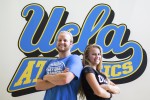It was a century ago when the Pacific Coast Conference came into existence. The name has changed, schools have come and gone, but one thing remained constant for the long history of the league: Administrative decisions went largely without the input of the hundreds of thousands of student-athletes who have competed in the conference.
Until last week.
The Pac-12 broke history with its introduction of a new governance structure that weighs the vote of a student-athlete representative equal to that of an athletic director.
“For the first time in literally 100 years we have a voice in what directly impacts our everyday lives,” said sophomore women’s golfer Aliea Clark.
Clark and Patrick Woepse, a junior center on the men’s water polo team, are UCLA’s two representatives on the new Student-Athlete Leadership Team, and they join a trio of high-level administrators on the Pac-12 Council. UCLA’s three other members are Dan Guerrero, athletic director, Petrina Long, senior women’s administrator and Dr. Michael Teitell, faculty athletic representative.
Every school has two student-athletes on the team, but only one student will attend each meeting with the three administrators, giving every school a total of four representatives. The group of four, however, get just a single vote for their school, requiring the members of each institution to determine a collective stance.
These issues include everything from sponsoring a new sport – like the recent decision to include beach volleyball for the upcoming 2016 season – or negotiating the broadcasting deal with the Pac-12 Network.
The agreement to include student-athletes in the governance structure was made in October 2014 when the Pac-12 CEO Group, which consists of the presidents or chancellors from all 12 schools, voted to reform the Council. The move was the first of its kind across any of the Power Five conferences.
“We’re kind of the pilot program, but it’s almost a no-brainer to incorporate the student-athlete’s literal vote into what we do,” Woepse said. “They’ve done a really good job trying to represent us, but now we’re just physically involved in the process.”
Last week, at the first Pac-12 Council meeting of the 2015-2016 school year, Woepse stayed in Westwood while Clark and the administrative team traveled to San Francisco for two days of discussion and voting.
Pac-12 student-athletes have been involved in some policy in recent years, but only in the form of an advisory committee. Woepse and Clark also hold positions with the Bruin Athletic Council, a UCLA-specific group that represents each athletic team on campus. Their new roles with the conference help bridge the student-athlete leadership gap from the local to the national level.
The NCAA began its own form of student representation last January, giving three athletes from each of the Power Five conferences votes at the NCAA Convention. Redshirt junior football player Kene Orjioke is one of the Pac-12’s representatives in the new autonomy structure, and has participated in the Pac-12’s advisory committee. But, with 15 votes out of 80 total, the national model is significantly different from the conference’s new system.
With a delegation of four, Woepse said that the student-athletes are given a more tangible say in every decision.
“The athletic director, Dan Guerrero, all the way down to the student-athletes will be on equal ground on voting on things,” Woepse said.
In addition to Guerrero, UCLA’s other administrative voices are also equally weighed against one another in the council’s meetings. Long started her career 38 years ago as an undergraduate tutor while she attended Cal. She said that it was a great moment last week to have students join the council for the first time.
“I’m really, really proud,” Long said. “To see it come full circle in my career period, where they actually have a voice and are part of the official government structure – not just in an advisory capacity – is really exciting.”
Clark was the first UCLA student-athlete attendee last week, and the sophomore – one of only two underclassmen in the group of 24 – said she was excited about both the historic implications and the practical advantages of such a program.
“It’s such a huge honor to be involved in such a forward-thinking, liberal leading conference,” Clark said. “The Pac-12 is always ahead of the curve when it comes to including benefits, or helping student-athletes and just caring about us. I really hope the other conferences follow suit.”
With both the NCAA’s autonomy structure and the Pac-12’s foray into student-athlete involvement, Long said that she thinks all the other Power Five conferences are looking at the issue now. While describing the conference’s current model as “robust,” she said that there will certainly be changes as the program adapts in these flexible early stages.
The next step, she said, should be garnering feedback from the students, the newest members of the council.
“I’m not saying we’re the model yet, but it would be great if we could build towards a model that we can share with other people,” Long said. “We’re making a really genuine effort to work with the great talent we have in our wonderful students.”
